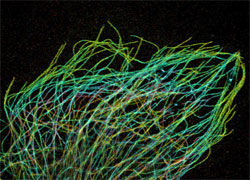
We were excited to learn this morning that our grantee William E. Moerner will share the 2014 Nobel Prize in chemistry with Eric Betzig and Stefan W. Hell “for the development of super-resolved fluorescence microscopy.” We congratulate them on this well-deserved recognition of their pioneering work, which has provided an unprecedented window into the cell and paved the way for understanding a range of biological processes.
I’m particularly thrilled with today’s news because it highlights an NIGMS-supported field that I’ve been closely involved in for more than 15 years. I remember my first conversation with W.E. on moving single-cell spectroscopy into biology, which led to a 2000 workshop we held to explore the state of the art in—and potential for—research in single molecule detection and manipulation. The recommendations from that workshop informed the development of a number of initiatives to apply the tools and approaches of the physical sciences to biological problems. The initiatives include our single molecule detection and manipulation program announcement and an NIH Roadmap for Medical Research program on the development of high-resolution probes for cellular imaging.
Since then, we have witnessed an explosion in the use of optical methods to look at single molecules at the nanoscale level and are gaining a wealth of insights as a result.
A statement from NIGMS on the prize is at http://www.nigms.nih.gov/news/results/pages/20141008.aspx. More information about our support of Nobel Prize winners is at http://www.nigms.nih.gov/education/pages/factsheet_NIGMSNobelists.aspx and at http://www.nigms.nih.gov/pages/GMNobelists.aspx.

